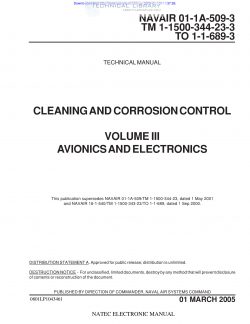NAVAIR-01-1A-509-3
- Version
- 363 Downloads
- 5.97 MB File Size
- 1 File Count
- March 7, 2017 Create Date
- March 7, 2017 Last Updated
Cleaning and Corrosion Control - Vol. III - Avionics and Electronics

1-1. 1-1.1. GENERAL. Today's military avionic Systems assume a significant share of the responsibility for mission completion, performance capability , and overall system safety. The role of avionics includes mission essential equipment, flight critical equipment, and aircraft hardware. For example, navigation, communications, electro nic warfare, weapon management, flight/engine controls and displays, and wiring are all considered avionics. Electronics and electrical power systems are also considered avionics. The reliability of thesecomplex systems in any environment is critical for aircraft flight and mission essential functions. Inthis manual, use Oftheterm "avionic systems" shall refer to any device that uses electrical power. The term "avionic technician" shall include the aviation electrician, aviation electronic technician, or any personnel authorized to perform maintenance on avionic systems. 1-1.2. Corrosion is a major cause Of avionic equipmentfailures, particularlywhile installed in military aircraft. In many cases, even minute amounts of corrosion can cause intermittent malfunction or complete failure of the equipment. Past experience shows that in order to obtain certain electrical characteristics, for example, low electromagnetic interference (EMI), a compromise in the design selection of materials might be needed (for example, the use of conductive adhesive). Sometimes such compromises can lead to corrosion problems that are aggravated by exposure to varying environmental conditions (for example, EMI corrosion). Avionic equipment is routinely exposed to varying environmental conditions. These conditions include changing temperatures and pressures, varying humidity, dust, dirt, and industrial pollutants in the atmosphere that often initiate corrosion.
| File | Action |
|---|---|
| NAVAIR-01-1A-509-3 Cleaning and Corrosion Control - Vol. III - Avionics and Electronics.pdf | Download |

Comment On This Post